This is a Canon A35 F, a 35mm rangefinder camera produced by Canon of Japan starting in March 1978. The A35 F is notable as being the last manual focus rangefinder camera made by Canon, and the only rangefinder with an in-body electronic flash. This camera is part of Canon’s long-lived Canonet series, although it was never marketed that way. It’s position in Canon’s lineup would soon be filled by their automatic focus Sure Shot series a year later. Despite being the last of it’s kind, the camera has a sharp 5-element 40mm Canon lens, and a full program AE system for quality exposures every time.
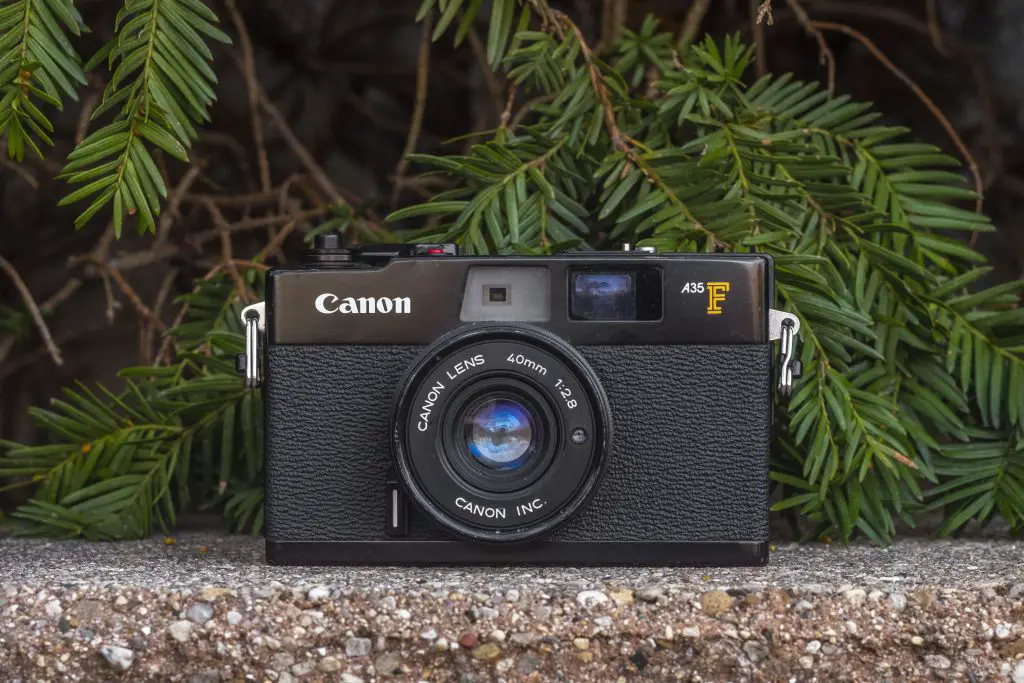 Film Type: 135 (35mm)
Film Type: 135 (35mm)
Lens: 40mm f/2.8 Canon Lens coated 5-elements
Focus: 2.6 feet to Infinity
Viewfinder: Coincident Image Coupled Rangefinder with Projected Frame Lines and Aperture Scale
Shutter: Electromechanical Leaf Shutter
Speeds: 1/60 – 1/320 seconds
Exposure Meter: Coupled CdS Cell w/ Full Programmed AE
Battery: 1.35v PX625 Mercury Battery (for the camera), 1x AA Alkaline Battery (for the flash)
Flash Mount: In-body Pop Up Flash
Weight: 496 grams
Manual: https://www.cameramanuals.org/canon_pdf/canon_a35_f.pdf
How these ratings work |
The Canon A35F was a last ditch effort for Canon to have something to sell pending the release of their first autofocus point and shoot camera a year later. This is an extremely basic camera with no manual controls but does have the added convenience of a pop up flash, which is not common on rangefinder cameras. Despite it’s minimalist feature set, it does have Canon’s excellent 5-element f/2.8 lens which is capable of very nice images, so if you’re in the market for a manual focus rangefinder camera, with completely automatic exposure, and a pop up flash, this is the model for you. | ||||||
| Images | Handling | Features | Viewfinder | Feel & Beauty | History | Age | |
| 2 | 1 | 0 | 1 | 1 | 0 | 0% | |
| Bonus | +1 because a score of 5.0 seems too low for this camera | ||||||
| Final Score | 6.0 | ||||||
History
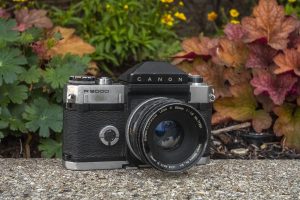
By 1961, when Canon was releasing the Canon 7, the market for high end interchangeable lens rangefinder cameras was starting to fall out of favor with photographers. The sudden rise in popularity of the Single Lens Reflex (SLR) in the late 1950s and early 60s meant that serious photographers were no longer interested in expensive rangefinder cameras. Canon knew that in order to stay on top of the market, they would need to include more SLRs and less rangefinders. That didn’t mean the rangefinder was completely dead however. SLRs were new and expensive, and there were a lot of amateurs and families that didn’t need a state of the art professional camera.
Enter the Canonet rangefinder of 1961. This original model had an all new solid body with a fixed f/1.9 45mm lens, a selenium cell exposure meter, and sold for under 20,000 yen which was less than half the price of a Canon 7 with 50mm f/1.4 lens. The Canonet rangefinder was an immediate success and sold very well as an intermediate option to higher priced SLRs and the high end Canon 7.
In 1963, an even more basic model, the Canonet Junior was released with an even smaller and lighter body, a 40mm f/2.8 lens, selenium cell exposure meter, but no rangefinder. It sold for 11,800 yen, a savings of almost 40% making it Canon’s first entry level “point and shoot camera”.
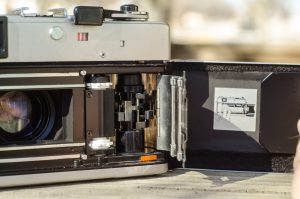
In 1965, Canon would release the Canonet QL17 which had an all new body design that was smaller and lighter than the original model, but contained advanced features like a CdS exposure meter, shutter priority auto exposure, and Canon’s new Quick Load feature which simplified film loading making it almost impossible to improperly insert a new roll of film. The QL17 was the top of the line of the Canonet series and offered photographers a very fast f/1.7 lens with excellent optics, an accurate exposure meter, and excellent rangefinder for a price of 23,800 yen, only 15% higher than the original model.
In the coming years, many different variants of the Canonet would come and go, some with f/1.9, f/2.5, and f/2.8 lenses. All models except the f/2.8 ones would have the QL feature and a rangefinder.
In 1969, Canon would once again redesign the Canonet series simply referring to them in marketing materials as the “New Canonet”. The body of the camera would not say it was the new model, but it was very easy to tell the difference as the new models were significantly smaller and lighter. Compared to the original QL17, the new QL17 was 20mm narrower, 4mm shorter, and weighed over 200 grams less. Despite these size reductions, the new model retained the same excellent f/1.7 6-element lens, QL feature, CdS exposure meter, and shutter priority auto exposure.
The rest of the line would follow with the “New” smaller and lighter bodies. Even the Canonet 28 would finally receive a rangefinder unlike earlier models which were scale focus only.
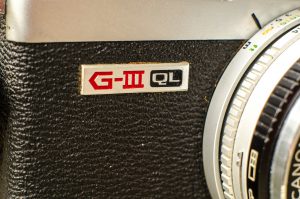
By 1972, the Canonet series was 11 years old, and even though it was a popular model, the winds of change were blowing once again. SLRs had been dominating the professional market for over a decade, but more and more intermediate and even some entry level models were starting to enter the marketplace which further ate into rangefinder sales. The time of the rangefinder was drawing to a close. Canon made one last effort to improve upon the Canonet, this time calling the top of the line model the Canonet G-III QL17. The “G-III” in the name indicated this was the third generation of the Canonet which might sound like a big deal, but in reality, other than a new battery check light, not much was different from the non G-III New Canonet QL17.
Although a very capable model, it was clear that the average snapshooter wanted something simpler to use. Features like automatic focus and in body electronic flashes were increasingly demanded by consumers and companies like Canon, Konica, and Minolta were hard at work at models with these features.
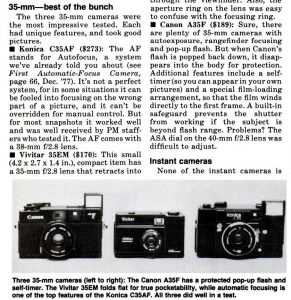
Konica would be first to market in late 1977 with an auto focus point and shoot camera with the Konica C35 AF, but Canon was not yet ready to release their competing model. In a sort of “consolation”, the company would release one more model in the Canonet line but without the Canonet name, called the Canon A35F that was still a manual focus rangefinder, but had an in body electronic flash.
The Canon A35 F was clearly a stop gap model meant to offer something new, without actually making anything new. I have to imagine that the use of both the letters A and F in the model name was intentional as Auto Focus was already generating a huge buzz with consumers. Canon would release their first Auto Focus point and shoot a year later and call it the Canon AF35M, simply changing the order of the letters and adding an ‘M’.
The Canon A35 F was essentially a Canonet 28, sharing it’s 5-element 40mm f/2.8 lens, but adding a pop up flash and removing all manual controls. It came only in black and originally retailed for $189, but was offered with steep discounts less than a year after it’s release
Today, there isn’t much of a market for fully automatic rangefinder cameras completely stripped of all manual controls like the Canon A35 F. I would be willing to bet most collectors have never seen this model before. It’s name which is similar to the Canon AF35, might suggest to some that it’s an autofocus camera, but upon closer look is an entirely manual focus Canonet rangefinder in a black body, and without the Canonet name. There are certainly better ways to experience Canon’s excellent rangefinders, but considering these cameras often go for very little, if you ever had a chance to pick one up, you could certainly do a lot worse.
My Thoughts

In my quest to build my camera collection, I can group how I got every camera into one of three categories. The first are those I very specifically wanted and sought out, paying whatever the market price (sometimes even higher) for. Cameras like my Nikon S2, the Kodak Medalist, and Minolta Super A are examples of this.
Then there’s cameras I wanted, but figured I would wait until I could find the price cheap enough, or to trade with some other collector for. The Canon IV Sb, my Rolleiflex K4A (which I have yet to review), and Kodak Ektra are in this group.
And then there’s cameras that I didn’t know I wanted, until they just showed up. Maybe they came in a lot of other cameras, or I stumbled upon one at an estate sale, or someone simply gave it to me free. The Canon A35 F is one of those cameras.
Being the last Canon rangefinder and the first with a built in electronic flash is a bit of an oddity. This was a camera with a feature set from an earlier era, with some modern conveniences that by the time of it’s release, had already started to appear in competitor’s models. To my knowledge, the Canon A35 F is the only manual focus 35mm rangefinder camera with a built in flash. The only other one I can think of would be the Olympus XA, but that camera relied on an optional flash attachment.
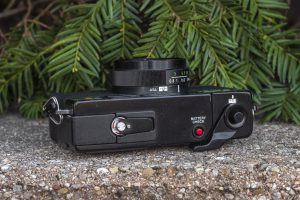
The top plate of the camera is a hybrid of old and new. The popup flash takes up the left quarter of the camera with the folding rewind handle to it’s right. I quite like this style of rewind handle that when folded is almost completely flat on the top, and when in rewind position, has a slightly longer arm for faster rewinding than previous Canonet models I’ve used.
To the right is a red battery check button, film advance lever with shutter release in it’s center, and then the automatic resetting exposure counter.
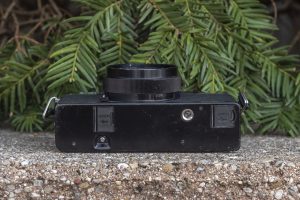
The bottom is where you’ll find the rewind release button, 1/4″ tripod socket and both battery compartments. Giving the impression that the flash unit on this camera was a completely separate development, grafted onto the body of a Canonet, the flash uses a single AA alkaline battery and the rest of the camera a 1.35v PX625 Mercury battery.
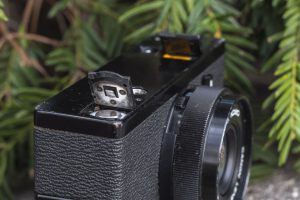
Canon had been using PX625 batteries all along on their Canonet series, and with this being the final model, I guess it doesn’t make sense for them to redesign the camera to use a different kind, but with having to include an AA battery compartment, how hard could it actually have been to adjust the camera’s circuitry for the voltage difference and just use a single compartment?
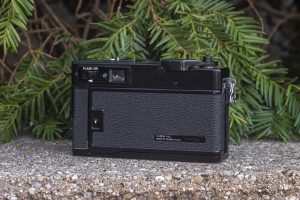
On the back is the film door that takes up almost the entire width, with a small part left over to house the flash battery. The door is opened by pressing down on the release latch. On my example, even after releasing the door, it wouldn’t pop open on it’s own, requiring me to stick my fingernails in the edges and pry it open. This likely could have been resolved if I had taken the time to replace the sticky light seals.
In the upper left corner is the Flash On switch, which not only pops up the flash, but begins charging it. From off to completely charged takes between 5-8 seconds depending on how strong the battery is.
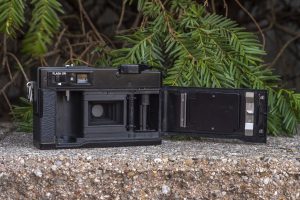
The film compartment is pretty basic, looking like a that of the Canonet QL17 GIII, except without the quick load feature. Film transport is from left to right onto a fixed and multi-slotted take up spool. The pressure plate is flat metal, with a metal roller and spring clips on other side to stabilize both the cassette and maintain film flatness as it transports through the camera.
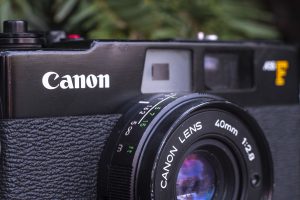
Like the Canonet 28 that the A35 F is based on, this camera has fully programmed auto exposure that takes care of all control over shutter speeds and f/stops. The CdS exposure meter is not TTL, but is within the filter ring of the lens, so automatically compensates when filters are attached to the camera.
Unlike the Canonet 28 which allows you to turn off Auto mode for flash pictures and control the aperture, the A35 F offers no such functionality. It is 100% fully automatic so you better hope the meter still works and the battery compartment is not corroded when you pick one of these up because there is no fallback option.
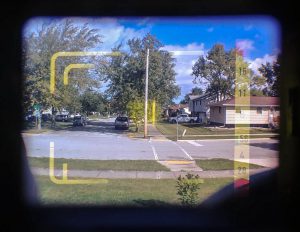
Up front, the only other control on the camera is a mechanical self timer below and to the left of the lens.
The viewfinder is straight out of earlier Canonets with a bright blue tinted main viewfinder, with yellow projected frame lines with parallax hash marks, a rectangular rangefinder patch, and an exposure scale that only shows f/stops. There is no indicator of what flash speed the camera has chosen, but with no speeds slower than 1/60, body shake should not be much of an issue. The viewfinder is of a good size and is easy to use, but seen here on a camera released in 1978 seems about 10 years out of date.
The Canon A35 F is very much a transitional model. With the camera to your eye, it feels like any classic rangefinder of the past, but with an in body flash and fully automatic exposure, it works like a point and shoot camera from the 1980s. The camera doesn’t offer anything new or different from any other models from the 20th century other than having the unique distinction of being both the last and first of an era.
Despite it’s less than inspiring feature set, I’ve gotten great images out of lesser cameras, so what is it like to shoot?
My Results
I didn’t expect much from this camera the first time I used it. In the summer of 2018 I had planned a trip downtown Chicago with several other cameras, and at the last moment threw the A35 F into my bag with a bulk roll of expired Kodak Tri-X 320. I figured if the images didn’t come out, it was no big loss as I have ton of that film.
Even though I had pretty low hopes for the camera, I expected that if I did get any images, the lens should perform pretty good, after all, this was the same 5-element Canon 28mm f/2.8 lens they were using in other cameras and you could probably get good images out of one even if you grafted one onto the side of the box camera.
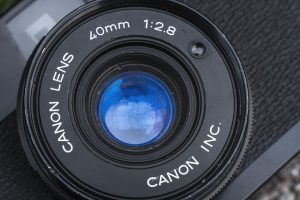
Thankfully, things worked out well as I got a roll of images that were technically fine. They were sharp across the frame without the optical anomalies you see in lesser lenses, but also lacking in inspiration. In a sort of “chicken or the egg” circumstance, I often wonder if a good camera can inspire good images, or if good images need to come from a good camera?
While shooting the A35 F was fine, and I had no major complaints, this is a cheap camera that never stops reminding you that it’s cheap. The film door creaked in my hands, the flash took a little coercing to get to come up all the way, and although the yellow tinted viewfinder worked fine, it seemed about 10 years out of date on a camera from 1978. I attempted to use the camera like a user who bought it new might, so I did a few shots with flash and once again, they turned out fine.
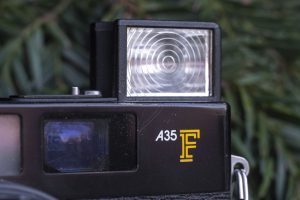
If you’re noticing my frequent use of the word “fine”, it’s because that’s pretty much what the whole shooting experience was….fine. There was nothing noteworthy, good or bad, about the experience. I didn’t necessarily mind that the camera was fully automatic with no manual control, as I’ve shot other fully automatic cameras before to good effect, but I could never help but shake the feeling that Canon really didn’t try very hard with this model. Looking at it’s specs and how it feels in your hands, it is clear that this was a half hearted attempt to release one more model before Canon’s first auto focus AF35M would be ready the next year. It was one more new SKU for camera shops to display on their Christmas 1978 ads. Simply, Canon didn’t try very hard with this camera and it shows.
Maybe I am being too hard, because like I said, it did what it was supposed to. I got some nice images from it and I bet that had I handed it to a more inspired photographer, they might have even gotten great images from it. From a vanity standpoint, the choice of an all black body with a bright yellow F on the front certainly is pretty, but there’s something to be said that I’ve had this camera for over two years and I haven’t touched it since it’s first roll of film in 2018. Had I felt compelled to come back to this camera even once since then, might have earned it a higher score.
Back to my chicken or the egg analogy, if you’re looking for something to inspire you to make great photos, this isn’t it. I got this Canon A35 F for free in a lot of other cameras, so with having nothing invested in it, I feel I got my money’s worth, and perhaps you will do, assuming you don’t invest a lot into it.
Related Posts You Might Enjoy
External Links
https://en.wikipedia.org/wiki/Canon_A35F
https://global.canon/en/c-museum/product/film99.html
https://blog.jimgrey.net/2013/06/10/canon-a35f/
https://www.lomography.com/magazine/50336-reviewing-the-sharp-and-stylish-canon-a35f
https://brianamorrison.com/personal/canon-a35f-a-journey-back-to-film/
http://www.theothermartintaylor.com/moveabletype/archives/cameras/000158.html

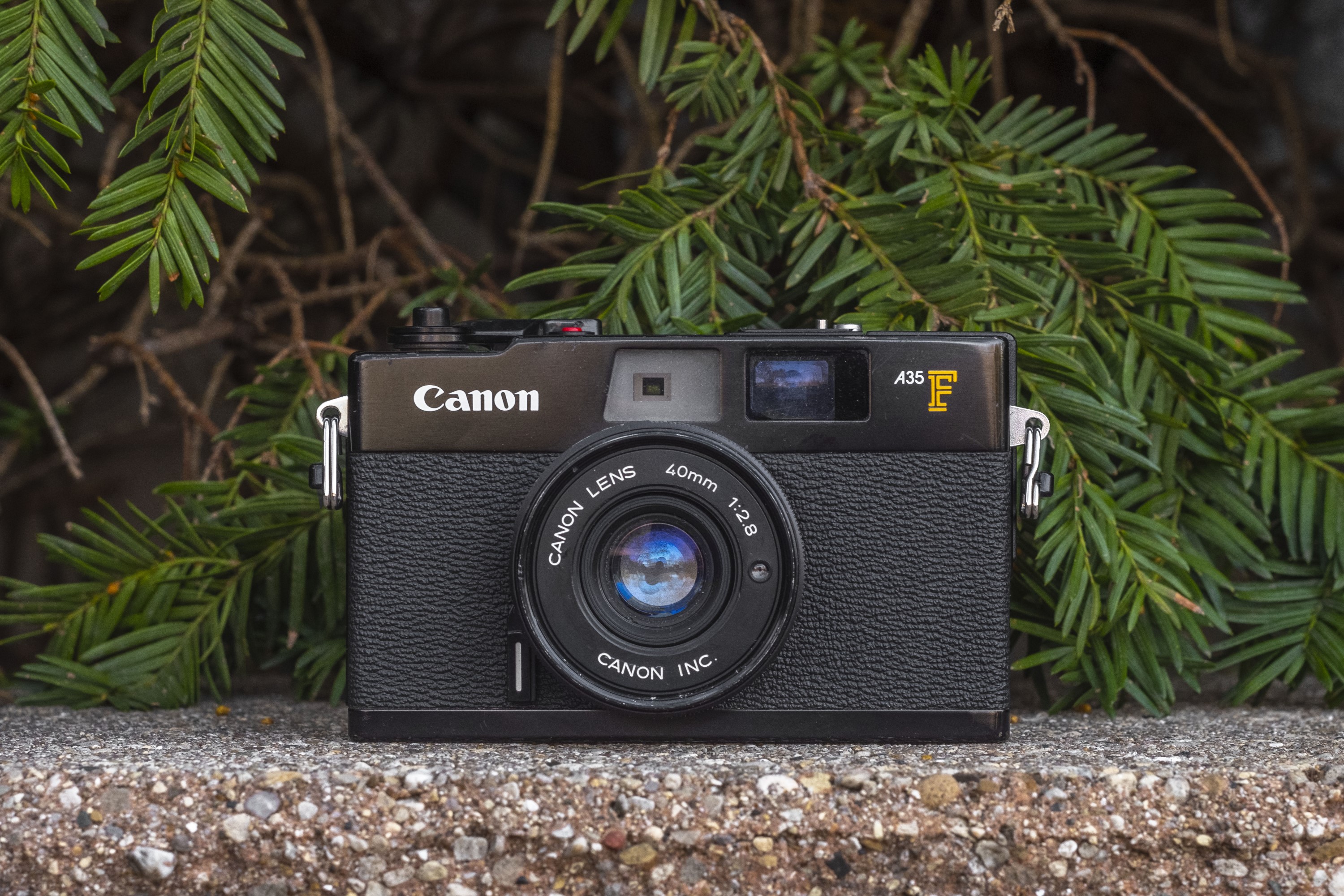
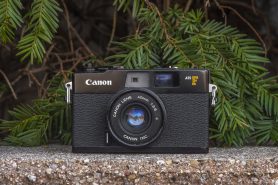











Some good photos of Central Camera pre-fire. Thanks for those.
Yes. To be perfectly honest, it was those pics that motivated me to finally do this review. I shot those in 2018 and they just sat in perma-draft status and I figured I needed to just publish it as I likely won’t ever shoot another roll through this camera again.
I had one of these and the film door was a pain to open on mine, too. That was why I ultimately sold the camera on. It was fine otherwise.
Nice weight, well balanced in the hand, short focus throw, smooth film advance…what’s not to like? I’ve got two.
Canon A35F lens is probably based on Canonet 28’s lens but is not the same. Canonet 28 has front element focusing and the rear element is placed behind the shutter. The lens in Canon A35 F is build as one piece and placed entirely in front of the shutter like in most P&S cameras of that era. Focusing is different too.The glass is 2.5mm wider and lens barrel shorter in A35F lens comparing to Canonet 28.
Canon A35F lens looks like an over sized P&S auto focus lens (similar to Nikon, Pentax and Yashica lenses found is 1980s P&S cameras).